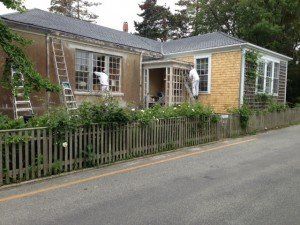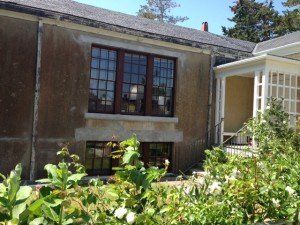Painting Has Begun on the Library Wing!
Now that the masonry is complete on the MMA’s Former Library – soon to become the EcologyLab – the painters have moved in. The first order of business is the original steel windows. A few will need repairs at a later time but in order to stop the rust from growing, we have gone ahead and painted the windows. The painter, Jim Tyler, and his crew began with a special primer paint for steel. It’s a lovely warm brown color and we all toyed for more than a few moments about keeping the windows brown. But historically, they were white so the crew applied several coats of white to the window sashes and trim. Next up will be painting the gutters and downspouts and finally the stucco. The stucco will be returned to its more grayish brown color which it was originally. The stucco we all see today does not appear to be the original final coating – a new layer of stucco was applied at some point in the mid-20th century. The paint on the stucco will be a mineral paint which is environmentally friendly and will also allow the stucco to breathe and release moisture, not trap it and cause humidity and water issues for the building.
You may have noticed some re-shingling on the east side along the street as well. This was done by carpenter Matt Anderson who works on historic structures. We noted that the building had only been re-shingled one time before on this elevation. Anderson also repaired and replaced gutters and downspouts on the wood portion of the building.
So keep your eyes open as you come up Vestal Street and stay tuned because we continue to plan for the interior. We have had the building cleaned by a professional company from off-island in anticipation of the natural science collections moving in when all work is completed. Currently, we are working with Landmark Facilities Group – an environmental engineering group that has worked on Mitchell House and on a system for the Archives and Special Collections – to develop an appropriate HVAC system for the collections and lab spaces. So while there might always be a lot of activity on the building – we are still working on it!
JNLF
Recent Posts






